
Rats actually make very good pets, as I discovered when my daughter Elissa had a series of them, starting in high school, and continuing when she was a graduate student at Duke University, in Durham, North Carolina. Natalia, a friend in the Biological Anthropology and Anatomy department, had pet rats as well, and on a couple of occasions, they were brought together for "play dates". The rats greatly enjoyed these events, although they were not without risk. One of Elissa's rats once caught a bad cold from another rat during one of these get-togethers, and it progressed into a fatal pneumonia. Pet rats tend to be sensitive to respiratory infections. Note 2
Madeline lived in an aquarium with a wire mesh top, but Elissa would sometimes take the cover off, and let her run around the room. On one of these excursions, Madeline didn't get very far, because as soon as she arrived at the rim of the aquarium, she saw a Kleenex® brand tissue. Madeline believed that a rat can never have enough good quality nesting material, so she grabbed the tissue and carried it down into the aquarium. She then set off on another outing, and immediately encountered another tissue. This was because the first tissue had come from a pop-up box that was standing next to the aquarium, and when she had taken the first tissue, another had popped up in its place. By the time Elissa called me in to see what was going on, Madeline was in full production mode. She was standing on the rim of the aquarium, grabbing successive tissues as each one popped up, and no longer carrying them, but just throwing them into the aquarium, which was about two-thirds full of loose tissues. Perhaps she figured that she could chew them up and arrange them later - the important thing was, a rat can never have enough nesting material! On another occasion, Madeline did a similar thing when she discovered a box of rat treats which we had neglected to remove from her table. She made multiple trips between the rat treat box and the aquarium, collecting as many rat treats as she could. She was pretty pissed off when we removed most of them and put them back in the box. Note 4 Wild mice did the same thing in my garage, actually. Cleaning up once, I found caches of dog biscuits all over the garage, which they had collected from a large bag after chewing a hole in the bottom. It seemed ironic to me that we were feeding, caring for, and loving one rodent in Elissa's room, while murdering others with snap traps in our garage and attic.
Another guest said that she had noticed the rat earlier, but hadn't wanted to say anything to our hostess about the apartment being rat-infested. She obviously didn't know the difference between a white laboratory rat and a street rat. Elissa used to let her rat crawl around under her shirt, from which it would pop out here and there. It was most surprising when she wore something low-cut, and the rat popped out in the center of her cleavage. Unfortunately, I don't think I have a photo of this. Elissa reports, "Many people have been amused by the fact that I used to buy my pet rat its own pet rat. This is how Hippo got her own pet rat, Lucy (the one who died of pneumonia), and Jezebel got Spuds (who became my primary rat after Jezebel died). Jezebel was the feeder rat. She was very timid until I got Spuds, who was more gregarious due to her fancy rat breeding. Spuds drew Jezebel out, and the two used to play together." The picture below shows Spuds (left) spooning with Jezebel in a Kleenex box. 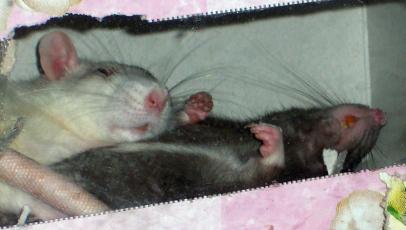 When Elissa returned to the Boston area from Durham after receiving her Ph.D. in Biological Anthropology, she brought Spuds with her. For a while, Margie and I took care of Spuds, because Elissa's roommate had a (shudder) cat. I bought Spuds an absurdly large and expensive cage for the last few months of her life. 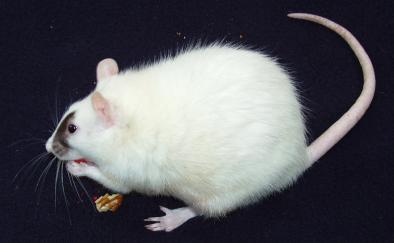 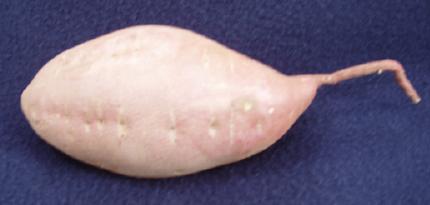 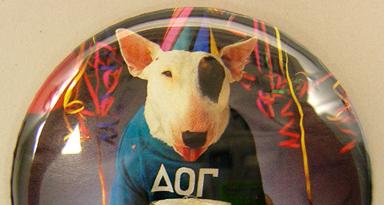
Answer: Spuds was named after Spuds McKenzie, the Budweiser "Party Animal". Note 5 Her resemblance to a potato came later, springing from our inability to stop giving her treats, because she was so cute. Alas, Spuds passed on to that great maze in the sky on June 25, 2006. She was 2½ years old, a good lifespan for a rat. Elissa noted, "She will be fondly remembered for her passion for Nutri-puffs and popcorn (and all other food), her inquisitive nature, and her inability to find her way out of her enormous cage." She will live on forever on this web page. I intend to live on that way, too - see my initial "blog"
entry, Introduction: what are these pages?. But on that page, I quoted Woody Allen:
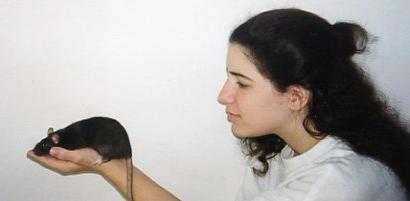 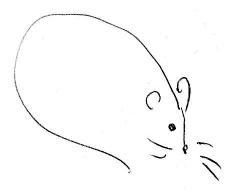 February 2011 update: I'm happy to see that Elissa has not lost her love of rats. Not long ago, I received a message sent by Elissa from a local pet store, with a few cellphone photos, and the note, "Look what they had at the pet store ... hairless rats!!! How cute!" 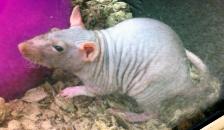    Note 1: A few people who read this entry when it was initially posted wrote me to say that what they find repulsive about rats is their rope-like tail. It doesn't bother me. November 24, 2012 update: I changed my squirrel photo to one taken in Conway, Massachusetts by my younger daughter Sara, over Thanksgiving. I made the switch because I think Sara's photo is better than the previous one I had used, and besides, the earlier photo was stolen from the Internet. This has been a bumper year for the squirrel population. [return to text] Note 2: Elissa notes, "We allowed [another friend] Steph's guinea pig to participate in the second bi-annual rodentfest, during which the first Rodent Olympics was held. Natalia's rat Pecan dominated in the stair climbing competition, but the guinea pig easily won the lettuce eating contest despite a late start. These events were followed by a viewing of the movie Stewart Little 2." Elissa added, "By the way, Natalia is famous! She discovered a new fossil species a few years ago - you can read the story of the fossil's accidental discovery during an expedition to the arctic." [return to text] Note 3: The word "fancy" in this context doesn't mean that they are elaborately ornamented. It rather has the less common meaning, "Bred for unusual qualities or special points". It's the same root word that appears in terms such as "dog fancier", meaning a person who likes dogs. [return to text] Note 4: OK, I admit to a certain amount of anthropomorphic poetic license when I imagine what Madeline was thinking. [return to text] Note 5: Spuds McKenzie was used in advertisements for Budweiser beer in the late eighties. He was portrayed as being fond of Budweiser and beautiful women. I recall reading at the time that if you asked the Anheuser-Busch brewing company, the makers of Budweiser, what kind of dog he was, they replied, "Spuds is not a dog - Spuds is a Party Animal". However, he was actually a bull terrier. Except "he" was a "she" - there was something of a scandal when it was ultimately revealed that the dog who played the part of Spuds was actually a bitch. At a Boston dog show once, I noted an area on the convention floor covered with sawdust, to create a place for dogs to urinate. A large sign over the enclosure read "DOGS". I noticed another such enclosure not far away, with another sign over it. But the sign was facing away from me, so I couldn't see what it said. If the enclosure nearby was for "DOGS", what was the other one for? "PEOPLE"? I walked around to the other side of the far enclosure. The sign read "BITCHES". That's when I discovered that to a dog fancier (see note 3, above), the word "dog" refers only to a male canine, and a female canine is called a "bitch", not a "dog". [return to text]
 |

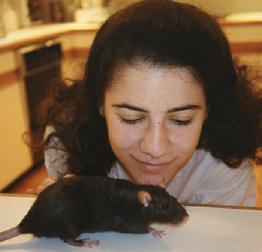
 Rats and mice like to crawl through small spaces, and pop up unexpectedly. While having dinner at a friend's house one day, our hostess suddenly reached down from her seat at the head of the table, picked up a white rat from the floor, and fed it a piece of spaghetti from her fork.
Rats and mice like to crawl through small spaces, and pop up unexpectedly. While having dinner at a friend's house one day, our hostess suddenly reached down from her seat at the head of the table, picked up a white rat from the floor, and fed it a piece of spaghetti from her fork.
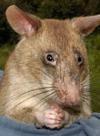 Pet rats are generally of the species Rattus norvegicus. But another very distantly related rodent, the giant Gambian Pouched Rat, Cricetomys gambianus, is being
Pet rats are generally of the species Rattus norvegicus. But another very distantly related rodent, the giant Gambian Pouched Rat, Cricetomys gambianus, is being